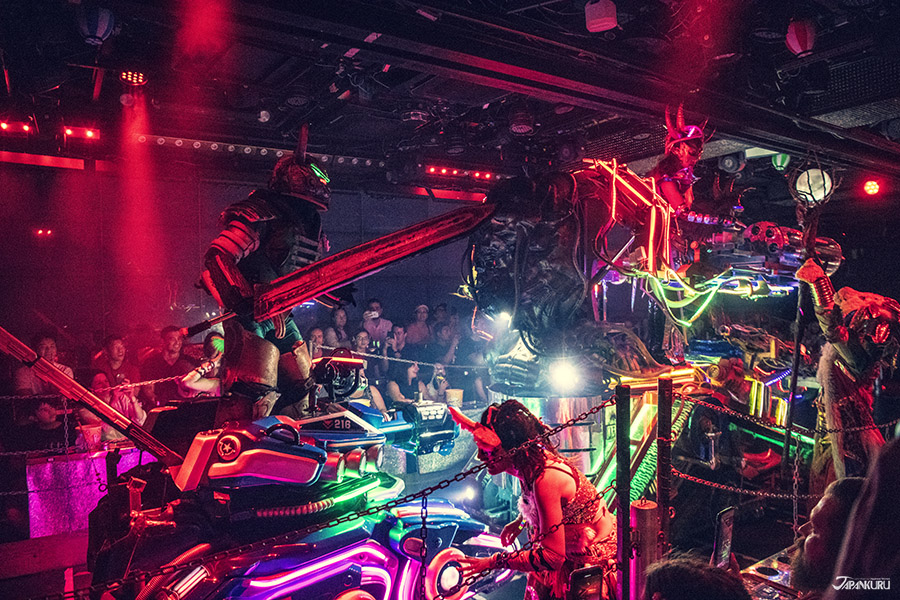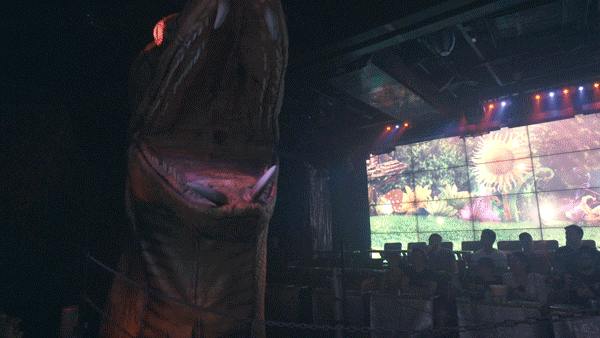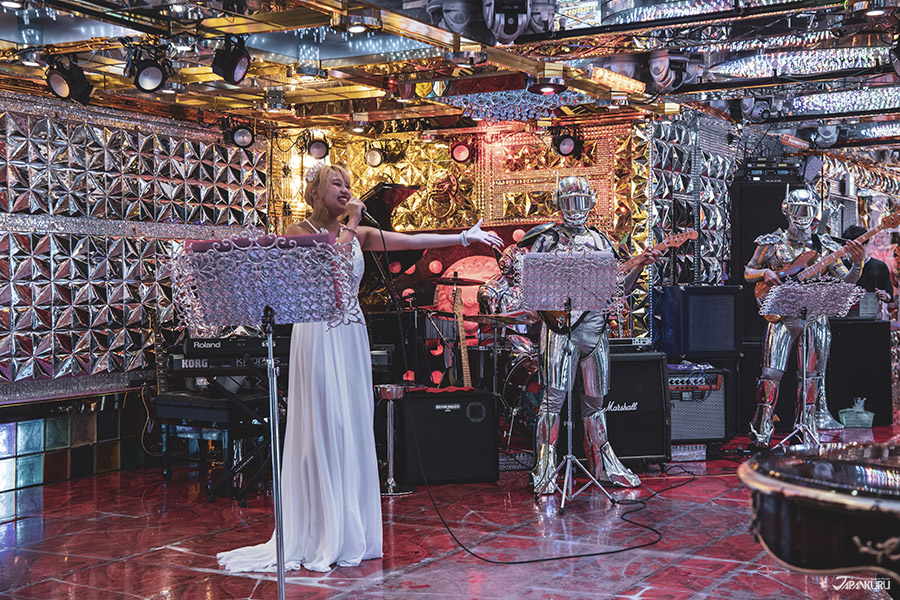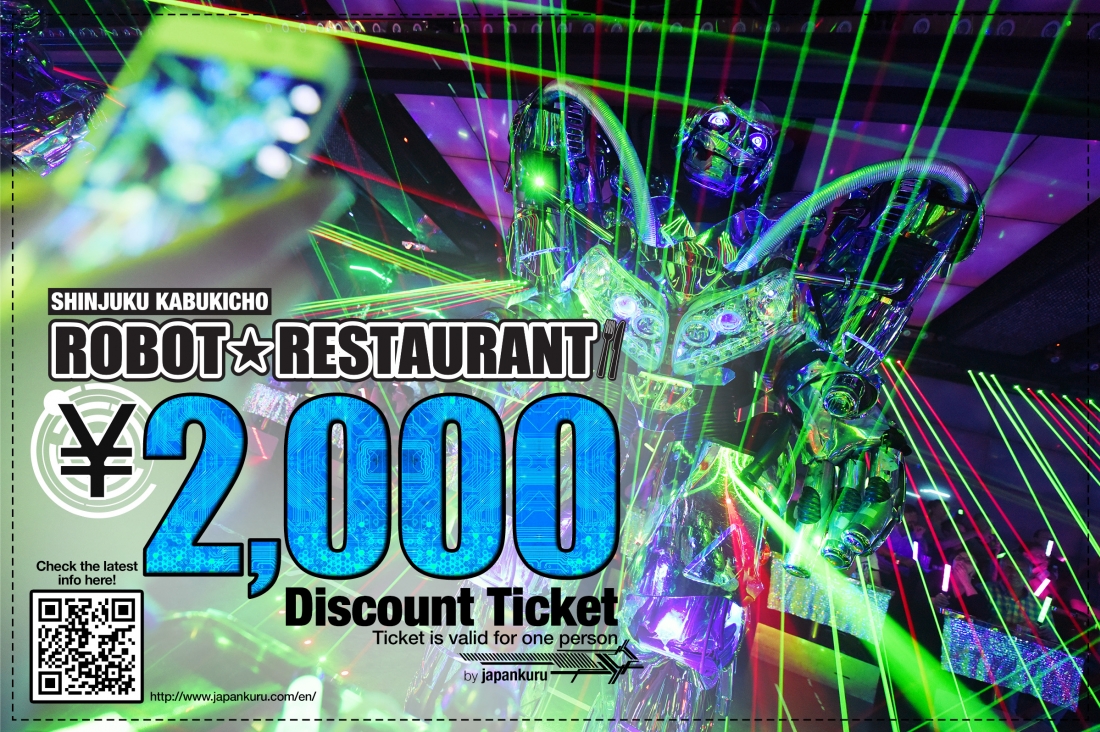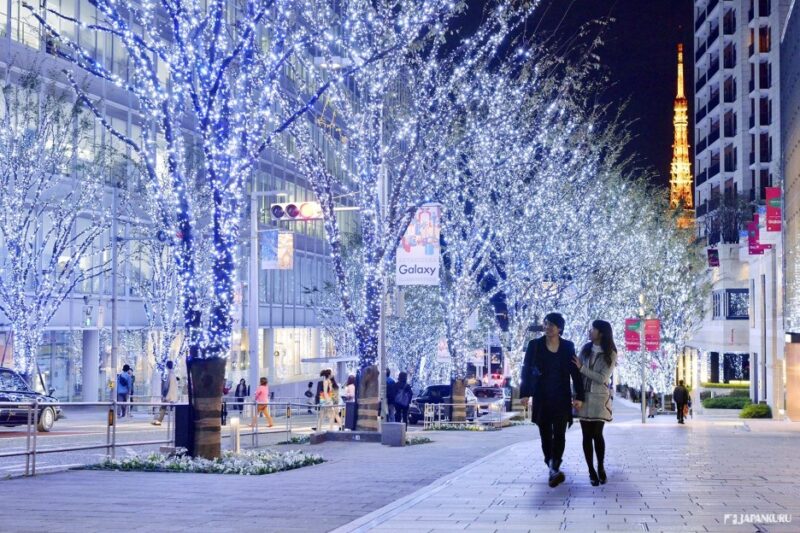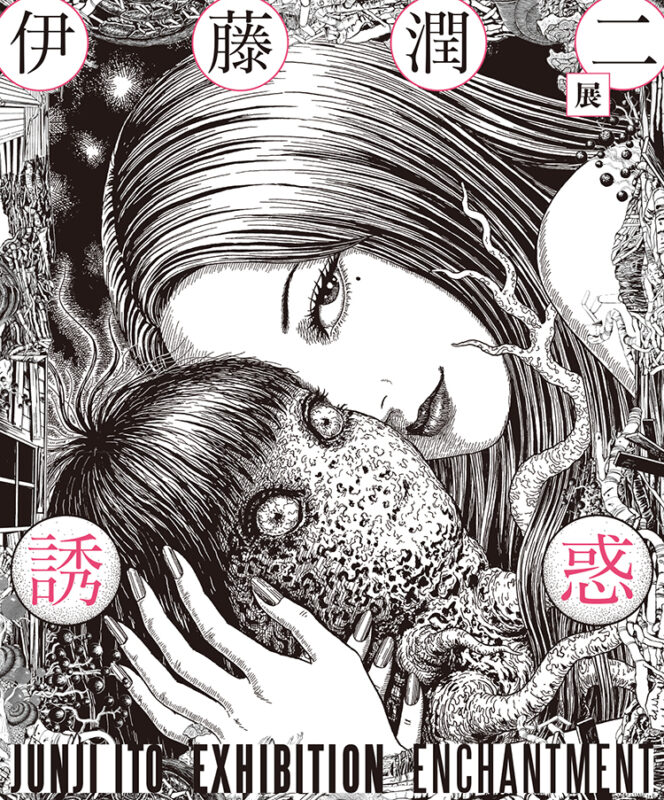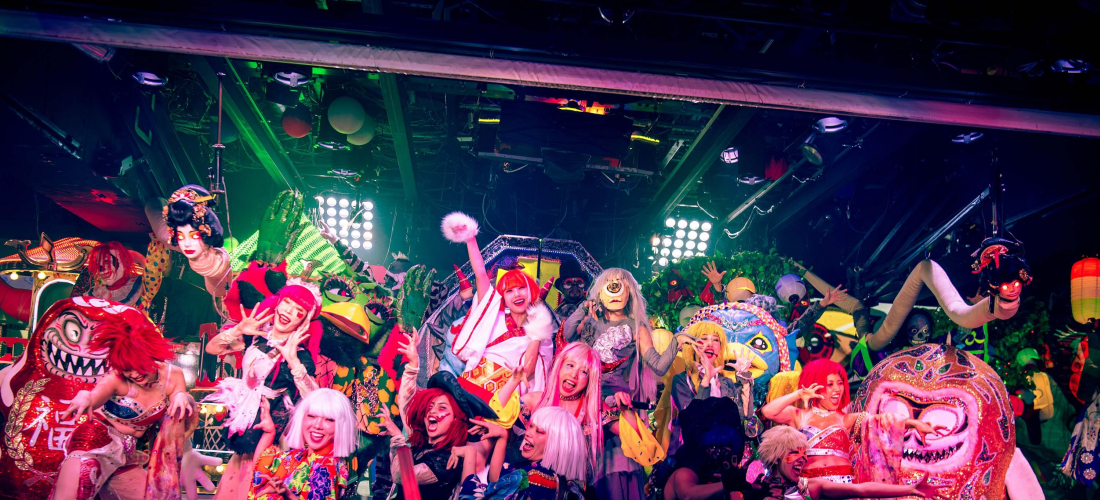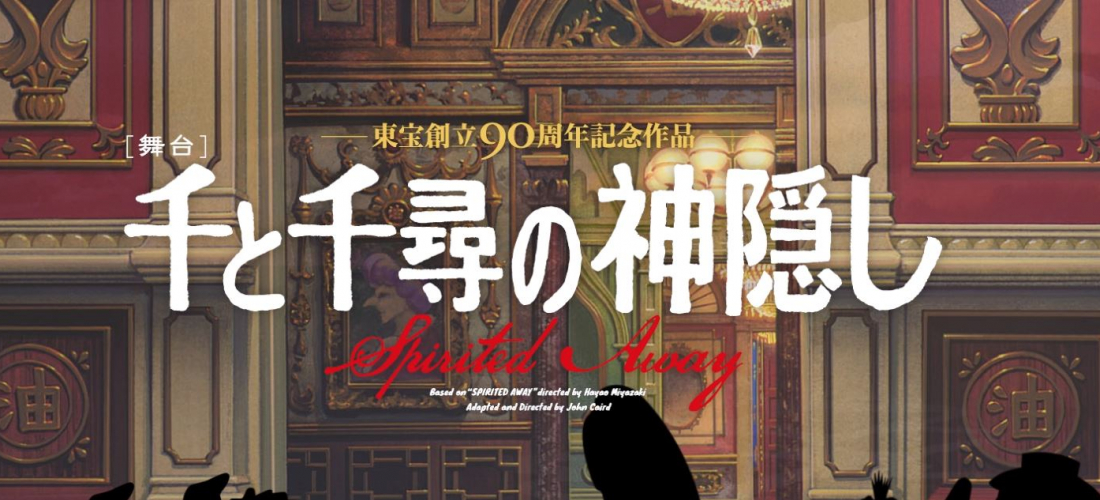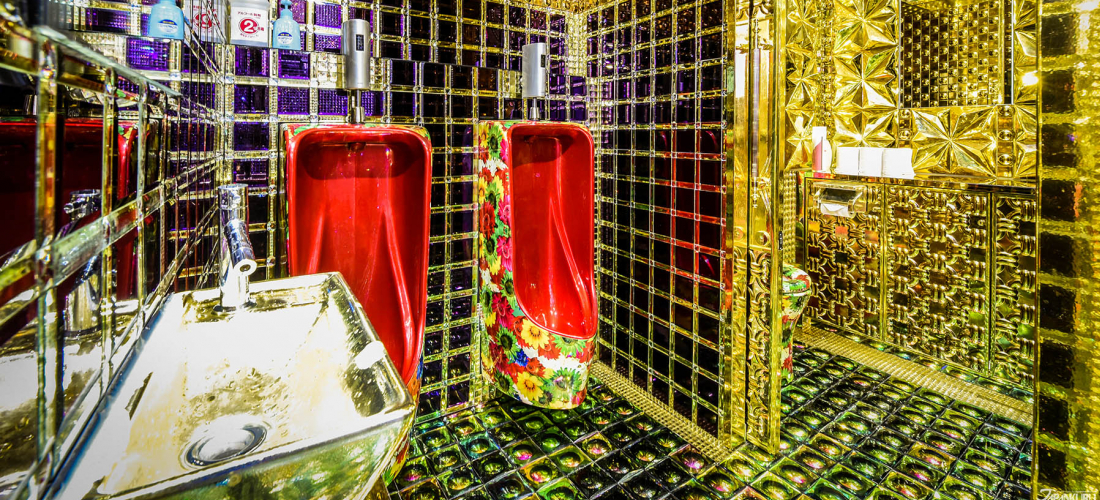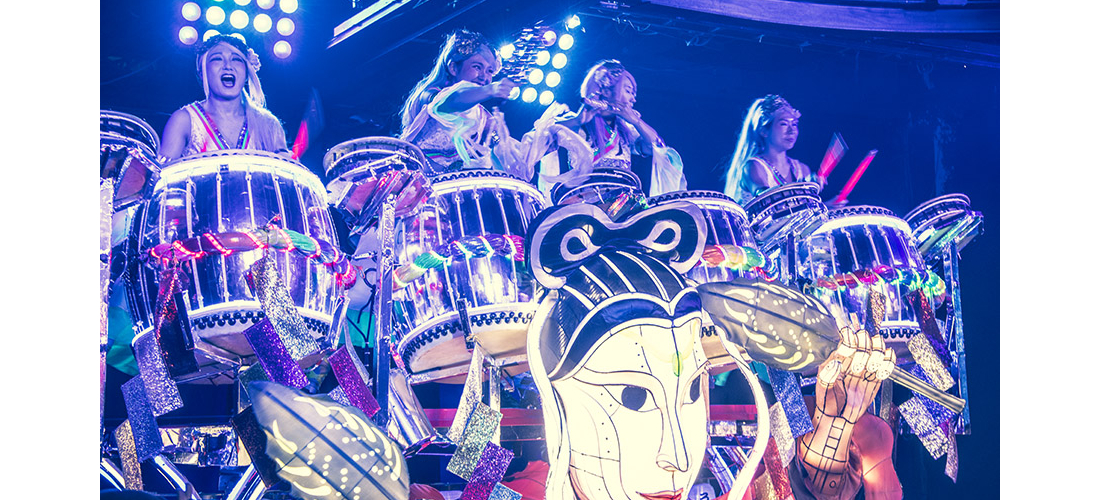
CONTENTS
Shinjuku’s Robot Restaurant is less restaurant and more show spectacular, but if you’re hoping to be dazzled for an evening, the Kabukicho spot is Tokyo’s go-to destination. Where else are you going to see Japan’s giant robotic contraptions, laser shows, and talented performers putting on a multi-part extravaganza every night of the week? It’s the place to be for anyone, young & old, who likes a fun night on the town, and a high-energy performance. (And don’t miss our Robot Restaurant discount coupon!)
Why spend an evening with the robots? 🤖
We've written in more detail about what you need to know to plan your trip to the Robot Restaurant here, but after our most recent 2019 visit, we thought we'd talk about exactly why you should spend a night making giant robot friends in Shinjuku. Whether you're a backpacker, a luxury traveler, or a family with young children – if you're on the fence about seeing the super-glitzy robot-filled show, read on and let us tell you why it's not to be missed!
Reason ①: It’s A Melting Pot of Old and New
Visitors often remark on Japan's ability to combine tradition and modern culture. With metropolitan spots like Tokyo Sky Tree and 1000-year-old Shinto shrines found just steps away from each other, it's easy to see why.
A trip to the Robot Restaurant will give you that same feeling, with visions of ancient Japan mixed into an undeniably futuristic, technology-supported show. The performance features traditional taiko drummers… riding on robotic parade-float-like structures, and bits of story clearly based on Japanese mythology… acted out by young women in neon cyan wigs, or riding on life-size animatronic dinosaurs. The show gives you an intense look at what Japan does best, mixing deep history and technological prowess.
Reason ②: The Visuals are Amazing!
There's no denying it, every part of the Robot Restaurant, from the moment you walk in to the final seconds of the show, have some serious impact. Frequent social media users can't resist the chance to take selfies in the colorful stairway and the glittering lobby, or to share clips of the flashy laser light show mid-way through. If you want something to impress your followers, you've found it.
Even the huge fashion house Dior couldn't avoid the temptation, and held a fashion show pre-party in the Robot Restaurant before a large Tokyo event in 2018. The glitz of the robots is a hit with everyone from globetrotting celebrities to casual travelers. Of course, it's a treat for your eyes, even if you're not much of an "influencer."
Reason ③: It’s Fun for Robot-Lovers of All Ages, And Groups of All Kinds
The Robot Restaurant sometimes comes off as a destination for adults, but they work hard to accommodate all guests (of all ages!) The spot has a well-deserved reputation for being loud, but they provide hardy sound-blocking earmuffs for those with sensitive ears (and little kids). Boxed meals are sold, but with more snacks and drinks available than full meals, think of it as more of a fun show than a relaxing evening meal and everyone will have a great time.
Got kids who love flashing lights, dinosaurs, robots, and heroes in colorful costumes? Grab a tub of popcorn, a colorful soda, and make it a family trip!
Want an exciting night out with a special someone? Whisk your significant other away in the fun of the light shows, and wave your light-sticks along with the music together. (For a romantic surprise, look out for the chocolates tossed to the audience during the show.)
Ready to get a little crazy with some friends? Pick up a round of beers and cocktails in the waiting room and enjoy the wacky atmosphere.
If you're in Japan for your birthday, don't forget to mention it to the staff. You might just get an extra special photo-op, and some birthday popcorn.
Don’t Skip These Easy-to-Miss Parts
Not-to-Miss ①: The Outdoor Robot Photo-Op
To get the most out of your trip to the Robot Restaurant, you'll want to get there a little early. That'll give you time first-thing for a photoshoot with the huge robot chairs found in a little enclave along the building's outer wall. To sit down in these you have to climb up a step-ladder before cozying right up to your giant robot friend of choice.
Putting together the Robot Restaurant apparently cost a whopping 10 billion yen, and a look at how imposing just the outdoor decorations are gives you a sense of how that's even possible.
Not-to-Miss ②: The Bathrooms!
Shining gold tiles, rainbow chrome, floral patterns in vivid primary colors, and we're not just talking about the walls. Every inch of the Robot Resturant bathrooms is just about as flashy as a bathroom can get. A single picture can only show you so much – you'll just have to visit yourself to see how glamorous a toilet can get.
Not-to-Miss ③: The Waiting Room Pre-Show
We highly recommend you arrive in time for the opening pre-show; it's impressive enough that the uninitiated might be fooled into thinking it's the main event. The glamor of the waiting room certainly doesn't hurt! Rainbow lights flash off of a million reflective surfaces, and wonderfully kitschy sea-shell chairs make up some of the audience seating. The pre-show itself is more musical, with a handful of talented vocalists belting out covers of Western and Japanese hits, standing in front of a band in robot costumes and behind a group of costumed dancers.
And Don’t Forget Your Discount Coupon!
Tickets for the Robot Restaurant are normally 8,000 yen, but we've got a special 25% off discount coupon for your next trip! To save the 2,000 yen, just show the staff the coupon on your phone (or print it out if you'd prefer), and they'll be able to scan the QR code to validate it.
Robot Restaurant Shinjuku
Entrance Fee: 8,000 yen/person* (with JAPANKURU coupon: 6,000 yen!)
Show Length: 90 min
Business Hours: 12:00 – 23:00
Inquiry Hours: 10:00 – 22:00
Official Website (en)
(Online Reservations)
*The 8,000 yen price (or discounted 6,000 yen) does not include food. Lunch boxes are available for an additional 1,000+ yen, along with other snacks.
A Rundown of the Show:
Let Us Whet Your Appetite for Raucous Robots
The Show ①: Taiko Drum Battles & Japanese Festival Celebrations
If you love that touch of truly traditional Japan, the dramatic opening sequence of this show might be your favorite part. Two teams of drummers enter into a face-off, one team clad in sky blue and looking a bit angelic, and their opponents with red outfits and an evil glint in their eyes. The drumming builds, warming up the crowd and getting everyone into a Japanese festival mood.
The Show ②: Monstrous Showdowns
The over-the-top competitive spirit of the show doesn't finish with the last drum beat! Keep watching and you'll see a series of battles, between mythological creatures, between dinosaurs, and between mystical human figures! Each fight is unique, and brings in different kinds of robots, costumes, and performances.
Who will you root for?
The Show ③: The Laser-Filled Light Show
Don't think for a moment that the show will get repetitive – new things to see and hear are constantly being added to the drama, including the sensational laser show. Dancers and robots move in and around the beams of light, playing with them as if the streams of light reacted more like solid objects.
The Show ④: A New Finale, Bringing the World Together
The most regularly changed part of the Robot Restaurant show is the finale. The final celebratory parade brings all the performers back onto stage for a final explosion of music and movement, before giving the audience a last goodbye.
For our most recent visit, things finished up with a sort of international parade. The crew jumped around sporting international flags as part of their outfits, hyped up and singing along to Michael Jackson. For the JAPANKURU team, things certainly ended on a high note!
After hearing a little more about the Robot Restaurant, and the treasures found inside, are you ready to take a trip over yourself? If you want some more concrete advice on how to plan your visit, we've written about the process before, so give our other article a look through and you'll be ready to go!
⇩⇩⇩
Details
NAME:Shinjuku Robot Restaurant
MAP
1-7-7 Kabukicho, Shinjuku-ku, Tokyo
ACCESS:Shinjuku Station
COMMENT
FEATURED MEDIA
VIEW MORE 
A New Tokyo Animal Destination: Relax & Learn About the World’s Animals in Japan
#pr #japankuru #anitouch #anitouchtokyodome #capybara #capybaracafe #animalcafe #tokyotrip #japantrip #카피바라 #애니터치 #아이와가볼만한곳 #도쿄여행 #가족여행 #東京旅遊 #東京親子景點 #日本動物互動體驗 #水豚泡澡 #東京巨蛋城 #เที่ยวญี่ปุ่น2025 #ที่เที่ยวครอบครัว #สวนสัตว์ในร่ม #TokyoDomeCity #anitouchtokyodome

Shohei Ohtani Collab Developed Products & Other Japanese Drugstore Recommendations From Kowa
#pr #japankuru
#kowa #syncronkowa #japanshopping #preworkout #postworkout #tokyoshopping #japantrip #일본쇼핑 #일본이온음료 #오타니 #오타니쇼헤이 #코와 #興和 #日本必買 #日本旅遊 #運動補充能量 #運動飲品 #ช้อปปิ้งญี่ปุ่น #เครื่องดื่มออกกำลังกาย #นักกีฬา #ผลิตภัณฑ์ญี่ปุ่น #อาหารเสริมญี่ปุ่น

도쿄 근교 당일치기 여행 추천! 작은 에도라 불리는 ‘가와고에’
세이부 ‘가와고에 패스(디지털)’ 하나면 편리하게 이동 + 가성비까지 완벽하게! 필름카메라 감성 가득한 레트로 거리 길거리 먹방부터 귀여움 끝판왕 핫플&포토 스폿까지 총집합!
Looking for day trips from Tokyo? Try Kawagoe, AKA Little Edo!
Use the SEIBU KAWAGOE PASS (Digital) for easy, affordable transportation!
Check out the historic streets of Kawagoe for some great street food and plenty of picturesque retro photo ops.
#pr #japankuru #도쿄근교여행 #가와고에 #가와고에패스 #세이부패스 #기모노체험 #가와고에여행 #도쿄여행코스 #도쿄근교당일치기 #세이부가와고에패스
#tokyotrip #kawagoe #tokyodaytrip #seibukawagoepass #kimono #japantrip

Hirakata Park, Osaka: Enjoy the Classic Japanese Theme Park Experience!
#pr #japankuru #hirakatapark #amusementpark #japantrip #osakatrip #familytrip #rollercoaster #retrôvibes #枚方公園 #大阪旅遊 #關西私房景點 #日本親子旅行 #日本遊樂園 #木造雲霄飛車 #히라카타파크 #สวนสนุกฮิราคาตะพาร์ค

🍵Love Matcha? Upgrade Your Matcha Experience With Tsujiri!
・160년 전통 일본 말차 브랜드 츠지리에서 말차 덕후들이 픽한 인기템만 골라봤어요
・抹茶控的天堂!甜點、餅乾、飲品一次滿足,連伴手禮都幫你列好清單了
・ส่องมัทฉะสุดฮิต พร้อมพาเที่ยวร้านดังในอุจิ เกียวโต
#pr #japankuru #matcha #matchalover #uji #kyoto #japantrip #ujimatcha #matchalatte #matchasweets #tsujiri #말차 #말차덕후 #츠지리 #교토여행 #말차라떼 #辻利抹茶 #抹茶控 #日本抹茶 #宇治 #宇治抹茶 #日本伴手禮 #抹茶拿鐵 #抹茶甜點 #มัทฉะ #ของฝากญี่ปุ่น #ชาเขียวญี่ปุ่น #ซึจิริ #เกียวโต

・What Is Nenaito? And How Does This Sleep Care Supplement Work?
・你的睡眠保健品——認識「睡眠茶氨酸錠」
・수면 케어 서플리먼트 ‘네나이토’란?
・ผลิตภัณฑ์เสริมอาหารดูแลการนอน “Nenaito(ネナイト)” คืออะไร?
#pr #japankuru #sleepcare #japanshopping #nenaito #sleepsupplement #asahi #睡眠茶氨酸錠 #睡眠保健 #朝日 #l茶胺酸 #日本藥妝 #日本必買 #일본쇼핑 #수면 #건강하자 #네나이토 #일본영양제 #อาหารเสริมญี่ปุ่น #ช้อปปิ้งญี่ปุ่น #ร้านขายยาญี่ปุ่น #ดูแลตัวเองก่อนนอน #อาซาฮิ

Japanese Drugstore Must-Buys! Essential Items from Hisamitsu® Pharmaceutical
#PR #japankuru #hisamitsu #salonpas #feitas #hisamitsupharmaceutical #japanshopping #tokyoshopping #traveltips #japanhaul #japantrip #japantravel

Whether you grew up with Dragon Ball or you just fell in love with Dragon Ball DAIMA, you'll like the newest JINS collab. Shop this limited-edition Dragon Ball accessory collection to find some of the best Dragon Ball merchandise in Japan!
>> Find out more at Japankuru.com! (link in bio)
#japankuru #dragonball #dragonballdaima #animecollab #japanshopping #jins #japaneseglasses #japantravel #animemerch #pr

This month, Japankuru teamed up with @official_korekoko to invite three influencers (originally from Thailand, China, and Taiwan) on a trip to Yokohama. Check out the article (in Chinese) on Japankuru.com for all of their travel tips and photography hints - and look forward to more cool collaborations coming soon!
【橫濱夜散策 x 教你怎麼拍出網美照 📸✨】
每次來日本玩,是不是都會先找旅日網紅的推薦清單?
這次,我們邀請擁有日本豐富旅遊經驗的🇹🇭泰國、🇨🇳中國、🇹🇼台灣網紅,帶你走進夜晚的橫濱!從玩樂路線到拍照技巧,教你怎麼拍出最美的夜景照。那些熟悉的景點,換個視角說不定會有新發現~快跟他們一起出發吧!
#japankuru #橫濱紅磚倉庫 #汽車道 #中華街 #yokohama #japankuru #橫濱紅磚倉庫 #汽車道 #中華街 #yokohama #yokohamaredbrickwarehouse #yokohamachinatown

If you’re a fan of Vivienne Westwood's Japanese designs, and you’re looking forward to shopping in Harajuku this summer, we’ve got important news for you. Vivienne Westwood RED LABEL Laforet Harajuku is now closed for renovations - but the grand reopening is scheduled for July!
>> Find out more at Japankuru.com! (link in bio)
#japankuru #viviennewestwood #harajuku #omotesando #viviennewestwoodredlabel #viviennewestwoodjapan #비비안웨스트우드 #오모테산도 #하라주쿠 #日本購物 #薇薇安魏斯伍德 #日本時尚 #原宿 #表參道 #japantrip #japanshopping #pr

Ready to see TeamLab in Kyoto!? At TeamLab Biovortex Kyoto, the collective is taking their acclaimed immersive art and bringing it to Japan's ancient capital. We can't wait to see it for ourselves this autumn!
>> Find out more at Japankuru.com! (link in bio)
#japankuru #teamlab #teamlabbiovortex #kyoto #kyototrip #japantravel #artnews
Photos courtesy of teamLab, Exhibition view of teamLab Biovortex Kyoto, 2025, Kyoto ® teamLab, courtesy Pace Gallery

Japanese Makeup Shopping • A Trip to Kamakura & Enoshima With Canmake’s Cool-Toned Summer Makeup
#pr #canmake #enoshima #enoden #에노시마 #캔메이크 #japanesemakeup #japanesecosmetics

⚔️The Robot Restaurant is gone, but the Samurai Restaurant is here to take its place. Check it out, and don't forget your coupon!
🍣신주쿠의 명소 로봇 레스토랑이 사무라이 레스토랑으로 부활! 절찬 쿠폰 발급중
💃18歲以上才能入場的歌舞秀,和你想的不一樣!拿好優惠券去看看~
#tokyo #shinjuku #samurairestaurant #robotrestaurant #tokyotrip #도쿄여행 #신주쿠 #사무라이레스토랑 #이색체험 #할인이벤트 #歌舞伎町 #東京景點 #武士餐廳 #日本表演 #日本文化體驗 #japankuru #japantrip #japantravel #japanlovers #japan_of_insta

Japanese appliance & electronics shopping with our KOJIMA x BicCamera coupon!
用JAPANKURU的KOJIMA x BicCamera優惠券買這些正好❤️
코지마 x 빅 카메라 쿠폰으로 일본 가전 제품 쇼핑하기
#pr #japankuru #japanshopping #kojima #biccamera #japaneseskincare #yaman #dji #osmopocket3 #skincaredevice #日本購物 #美容儀 #相機 #雅萌 #日本家電 #일본여행 #면세 #여행꿀팁 #일본쇼핑리스트 #쿠폰 #일본쇼핑 #일본브랜드 #할인 #코지마 #빅카메라 #japankurucoupon


